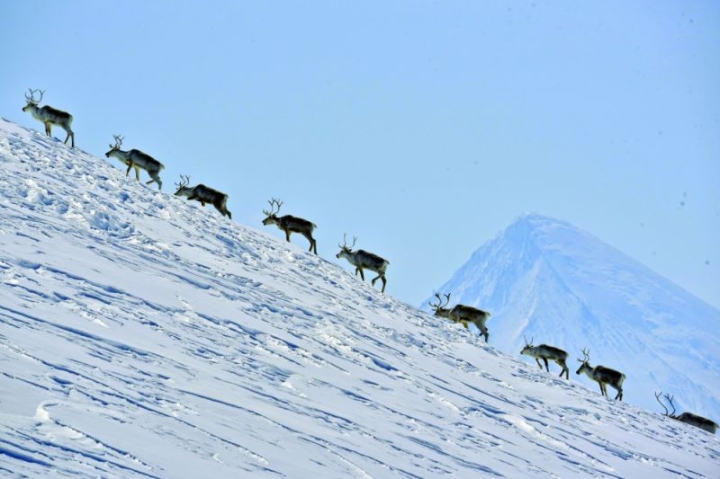
In the remote and pristine wilderness of Russia’s Kamchatka Peninsula, a crucial annual event is unfolding as the region’s last significant herd of wild reindeer embarks on its perilous winter migration. These majestic ungulates, a genetically distinct Okhotsk subspecies, are making their way into the rugged mountain ranges, seeking vital pastures as the harsh Siberian winter looms. This annual movement, occurring immediately after the mating season and preceding the heaviest snowfalls, is a critical passage for a population listed in Russia’s Red Book of endangered species.
Having concluded their rut, these iconic creatures, predominantly composed of females and their young, are now gathering into larger groups to ascend to high-altitude, wind-swept areas. Here, the snow cover typically remains thinner, granting them easier access to reindeer moss and lichen, their primary food source. This strategic move allows them to conserve crucial energy during the brutal winter months by avoiding the strenuous effort of digging through the deep snow that accumulates at lower elevations. The bulls, having expended considerable energy during the breeding season and having already shed their antlers, usually form smaller, separate groups or roam individually.
The Kronotsky Nature Reserve serves as the sole sanctuary for this unique wild reindeer population on the Kamchatka Peninsula, numbering approximately 800 individuals. Their exceptional isolation has led to genetic differences from their mainland relatives found in Chukotka and Magadan, highlighting their irreplaceable ecological value. Their continued existence is a testament to the pristine, yet challenging, environment of this far-eastern Russian territory, a region of immense global biodiversity importance.
Recognizing the critical status of these animals, a comprehensive three-year conservation project was initiated in 2024, bolstered by the charitable foundation “Far East and Siberia Ecosystem Preservation.” This vital initiative has equipped state inspectors with essential resources, including specialized winter uniforms, advanced radio communication devices, and modern satellite equipment for remote outposts, ensuring uninterrupted connectivity across the vast wilderness. Additionally, drones have been deployed to facilitate remote monitoring of the herds, significantly enhancing protective measures against potential poaching and other threats.
“Preserving the biodiversity of Kamchatka, especially rare species like the wild reindeer, is one of our strategic priorities,” stated Vsevolod Yakovlev, acting director of the Kronotsky Reserve. He further emphasized, “The reinforcement of protection for their winter habitats has been made possible through the Foundation. We are deeply grateful to our partners for their active involvement in the fate of these Red Book species residing within the Kronotsky Nature Reserve.” Environmental agencies and conservationists worldwide view such collaborative efforts as exemplary models for safeguarding vulnerable ecosystems globally.
This arduous trek from their summer and autumn grazing grounds in areas like the Kronotsko-Bogachevskaya tundra to their high-altitude winter refuges can span distances of up to 100 kilometers. These migration paths are not newly forged; they represent ancient routes traversed by generations of reindeer for centuries, deeply ingrained in their behavior and absolutely crucial for their long-term survival. The success of this annual migration serves as a vital indicator of the overall health of one of the world’s most untouched natural landscapes, underscoring the delicate balance required to preserve such unique biodiversity.